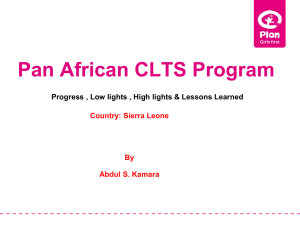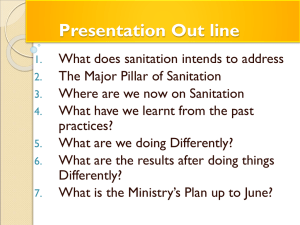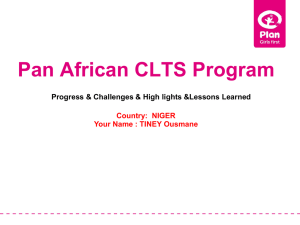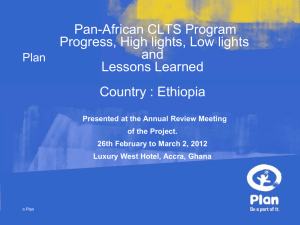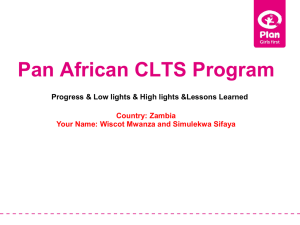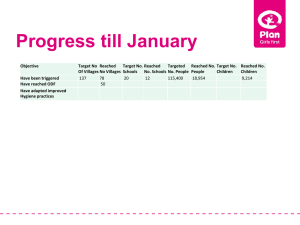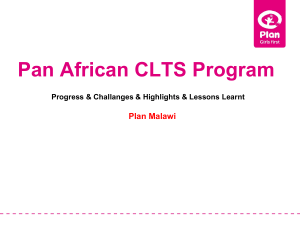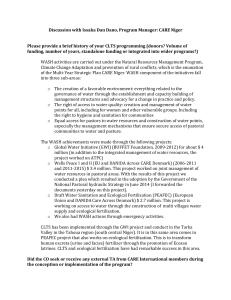CLTS and Scaling-up Rural Sanitation - Community
advertisement
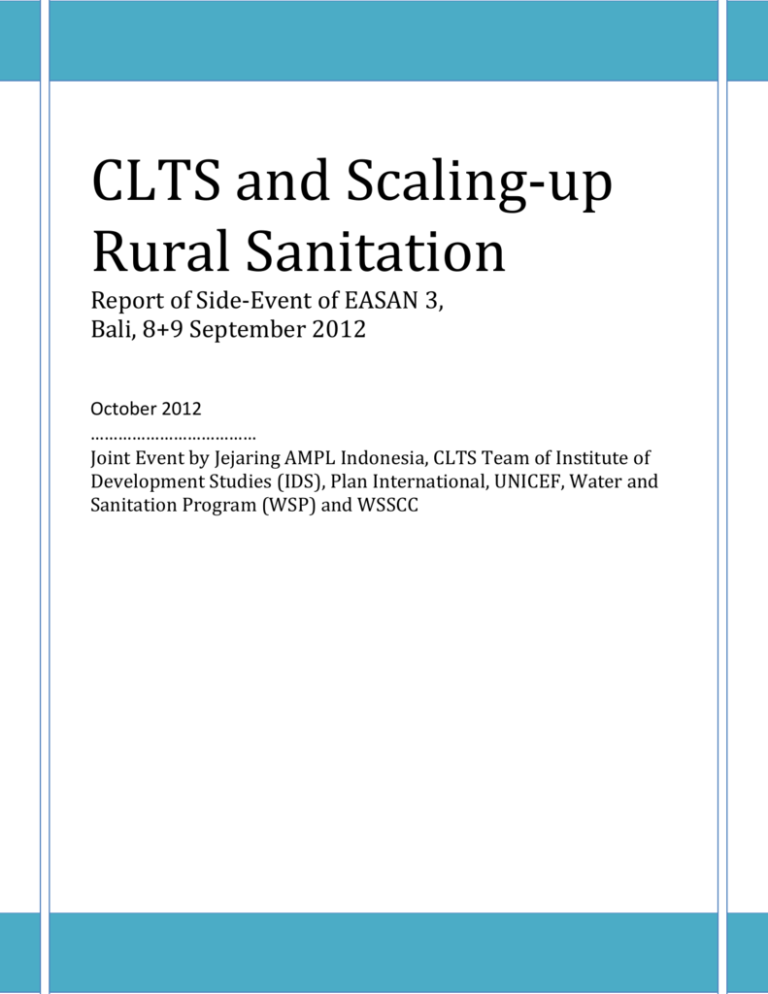
CLTS and Scaling-up Rural Sanitation Report of Side-Event of EASAN 3, Bali, 8+9 September 2012 October 2012 ……………………………… Joint Event by Jejaring AMPL Indonesia, CLTS Team of Institute of Development Studies (IDS), Plan International, UNICEF, Water and Sanitation Program (WSP) and WSSCC CLTS and Scaling-up rural sanitation Learning Workshop Side-Event of EASAN3, Bali, 8-9 September A two day learning workshop on Community-led Total Sanitation (CLTS) and scaling up rural sanitation in the East Asia and Pacific Region was held as a Side Event to the EASAN3 on 8 and 9 September. This workshop was jointly organized by Jejaring AMPL Indonesia, the CLTS team at the Institute of Development Studies (IDS), Plan International, UNICEF, WaterAid, WSP and WSSCC. Over 60 participants from 14 countries participated in the event. The list of participants is attached. The overall aim of the 2-day workshop of creating a stronger community of practice for CLTS and rural sanitation in the region, and hence ensuring quality expansion and scale-up of community-led approaches for sanitation and hygiene, with objectives as follows: to take stock of, and strengthen CLTS in the East Asia and Pacific Region – through opportunity for participants to share their experiences with colleagues from different countries and organisations, hearing from recent studies of and experiences with CLTS in other regions and discuss ways forward in taking CLTS to scale in the region. To strengthen mutual learning and evidence-based knowledge exchange between countries within North and East Asia and Pacific on what it takes to scale-up rural sanitation To share lessons and experiences amongst countries to inform implementation of at-scale programs, identify existing knowledge gaps and formulate strategic priorities for the region (feeding into EASAN3) To inspire participants by innovations taking place across the region in support of rural sanitation scale-up The following is a brief summary of the side event (day 1 and day 2 summary), with key messages at the end that were presented to the main EASAN 3 conference, integrated in the closing remarks of the Indonesian Government. 1 | Report EASAN3 Side Event – CLTS and Scaling-up Rural Sanitation Summary of Day 1 - 8 Sept 2012: CLTS The first day objective was to discuss recent studies and experiences with CLTS in East Asia and Pacific and other regions and discuss ways forward in taking CLTS to scale in the region. This note captures the main discussion from the first day of the meeting. The opening welcome was given by Prof Dr. Chandra Yoga Aditama, Director General of Disease Control & Environmental Health of Ministry of Health Indonesia. On behalf of the organizers Robert Chambers and Petra Bogartz from IDS noted how fitting it was for this meeting to be in Indonesia, the largest country in the world to have made CLTS a part of national sanitation policy and so there is much to learn from this country. Setting the scene in the region For this workshop 14 countries were considered in the East Asia and Pacific region1. In these 14 countries 85 million people are practicing Open Defecation, of which more than half are living in Indonesia. Within these 14 countries there is a range of contexts - five countries where less than 10% of the population practice OD, four countries with 10-30% OD, four countries with 30-50% OD and one country with over 70% OD (Cambodia). CLTS has been introduced in 12 of these countries, the two exceptions being DPR Korea and Vanuatu. From 2004 - 2008 CLTS was introduced in 8 countries. The second wave of introduction covered four countries from 2008 to 2012. CLTS in the region is being implemented in rural areas only (with the exception of Mongolia where there are some activities in peri-urban areas). Emerging key findings from the regional CLTS review A regional CLTS review was conducted in preparation for EASAN to understand the status of CLTS in the region and generate actions for strengthening impacts of CLTS in the region. The review was sponsored by UNICEF, Plan, WaterAid and WSP and conducted by Andy Robinson. Emerging findings from the review were presented at the event: The methodology was a desk based rapid review. For each country information was collected on: spread (organizational); geographical spread (proportion of country covered); scale (number of triggered and ODF communities and also population living in these communities); approaches (any adaptations to CLTS; major exceptions to CLTS); enabling environment (policy, plan, finance, monitoring sustainability, integration with other approaches); constraints and opportunities. Emerging findings of the review are highlighted below and tentative suggestions on why this may be happening are offered. Weak monitoring systems for CLTS: Conducting the review highlighted that data relating to CLTS is not readily available, even with CLTS program implementers. Why is this happening? In most cases there is no demand for this data and hence it is not generated. In contrast in other regions processes such as 1 Cambodia, China, DPR Korea, Indonesia, Kiribati, Lao PDR, Mongolia, Myanmar, Papua New Guinea, Philippines, Solomon Islands, Timor Leste, Vanuatu, Vietnam. 2 | Report EASAN3 Side Event – CLTS and Scaling-up Rural Sanitation joint sector reviews are generating demand for this data. A key question to address is "What will incentivize data collection?" Spread through the region: CLTS has spread through the region. More than 3 million people are now living in ODF communities2. Why has this spread occurred? Despite significant contextual variations, the CLTS approach is working in all countries and is more effective than earlier sanitation approaches. Scale takes time: There is a strong association between the time when CLTS was introduced and the scale of activities (across all the parameters reviewed). Additional time allows countries to develop on all fronts.. Why is this happening? Why did CLTS start in certain countries first? Were these countries progressive?; did they have low coverage and therefore government and development partner interest in new approaches?; Were certain actors present? - this causality is not clear. What is needed for countries to make the transition to a more developed CLTS programme - is it just time or other factors? Ad hoc implementation: Countries lack a coordinated strategy/plan for CLTS implementation taking CLTS to scale; implementation is mostly agency lead. Government not yet financing CLTS: With the exception of Indonesia, governments are providing only indirect support to implementation. Unclear how much capacity is being developed: It is hard to gather data on the number of facilitators trained and those who are still active and effective. Supportive policy: Existence of a supportive policy seems to be related to scale. A mixed policy message appears to hinder scale up and a supportive policy towards CLTS is a sign of a conducive enabling environment. Problems/constraints even for early adopters: For example in Cambodia the government still supporting both CLTS and hardware subsidy approaches; in Timor Leste the government is still financing subsidy programs and not behavior change and demand creation; may have expected to see more growth in these countries by now. ODF success rates - average 20%in the region compared to 39% in West Africa: We need to figure out what can be done to improve the success rate. Why is this happening? It looks like early adopter countries are better and may be learning how to improve success rates over time. It is hard to discern what is a result of poor implementation and what a weakness of the approach is. Subsidy programs in the same areas as CLTS are one of the constraints that may be affecting success. Sustainability issues: While not explored in detail this is still a major concern – there are issues of durability and follow-up and we don't know how many ODF communities are still ODF. Why is this happening? Whilst acknowledged as a challenge, resources are not allocated for sustainability mechanisms such as monitoring and follow-up. Priority issues for CLTS in the region The following issues emerged from participants as priority issues for CLTS in the region: 2 Two of the exceptions to this spread are: China where CLTS is being reintroduced for the second time, however technical standards on sealed tanks are a policy issue making it difficult to do CLTS; DPR Korea where most housing is provided by government and it is hard to see how CLTS can fit in. 3 | Report EASAN3 Side Event – CLTS and Scaling-up Rural Sanitation Policy and Advocacy: Such as how to get government buy in and create champions; building a compelling evidence base; developing an advocacy plan; involvement of high level decision makers to allocate funds to CLTS and support for a policy/strategy. Scaling up: Such as retaining good facilitators; Quality at scale; capacity to scale up; planning to reach universal access; moving to an area wide approach; having a team approach; need for a flexible methodology; scale up must be lead by government; engaging existing local institutions. Training, capacity building: Such as quality of facilitation; capacity building of facilitators; How to get the required number of facilitators and how to support facilitators to keep going; integrating CLTS into the curriculum of training institutes; more TOT training; ways to monitor the number of facilitators/trainers developed and what they are doing; building local government capacity; Technical advice on latrine options - good or bad - when? Are prescribed designs/technology a help or a hindrance? Guidelines on O&M. Sustainability: Such as sustainability of ODF - avoiding slippage; ODF verification standards; institutionalization into local government; key determinants of sustainability may be quality of facilitation, type of technologies used, community leadership and commitment. Monitoring, reliable data: ODF is being accepted as a good indicator and targets for ODF are being set in some countries and yet there is a lack of national monitoring systems for verifying and monitoring sustainability and quality of ODF; ODF verification - how to do this; Exploring further the use of ICT for tracking status; Challenges in obtaining honest and reliable data; need for better country level data (baseline/current) to understand what is happening based on a short list of agreed key indicators and harmonized reporting tools; do targets compromise quality - do we need to set targets? Systems to know what has been done by trainers/facilitators Financing: Financing for CLTS is coming mainly from NGOs and donors and not government budgets; Guidance needed to local government to allocate funds to CLTS; Micro- finance for CLTS - does it work? Difficulties faced by small scale sanitation providers when payments for sanitation products are received on an installment basis; targets not yet backed with budget lines; how to incentivize local government to spend on sanitation; changing mindsets to consider lending for software as a good investment. Issues of subsidy: Subsidy programs are still prevalent in many countries in the region and there is a duality of approaches in most countries even where policies supporting CLTS have been introduced; How to adapt CLTS to a subsidy context; If there is subsidy can we call it CLTS?; Non subsidy incentives good or bad and when?; Why is zero subsidy important? Difference between household and community subsidies (such as latrines in schools, health centers, market places; subsidizing transport costs of materials for the entire community) Local implementation issues: Such as: supporting villages where there is an increase in toilet usage but that don't reach ODF; different designs of program for different areas; such as remote communities; who is leading - community or others? Institutional relationships: Issues such as coordination; partnerships; local government support; engaging private sector. 4 | Report EASAN3 Side Event – CLTS and Scaling-up Rural Sanitation Vulnerable households: Such as serving and targeting vulnerable; what happens to different vulnerable groups through the CLTS process? Integrating approaches: Integration - How can we integrate other programs to capitalize on the success of triggering? Don't want to see reversion to OD; how should this be done? Sanitation Marketing difficult in remote areas; sequencing - triggering or marketing first?; synergies with marketing and CLTS; SLTS; Future research areas From the discussions a number of areas emerged that participants felt would benefit from further insight, either through documentation, further research or structured peer to peer interaction with time to reflect on both failures as well as successes. These areas included: Ways to build high level support for CLTS in countries in the region. This includes getting back to basics and communicating the case for CLTS and the evidence on the problems with subsidy approaches; developing key messages on the core elements and tools of CLTS to improve its acceptance. Ways to generate local government support and involvement in CLTS ODF verification: the process for doing this; the criteria used; ways to monitor sustainability of ODF. What are the reasons behind different ODF success rates? Getting more detailed on operation learning and innovations - how did things really happen to get high quality CLTS? How is CLTS training working – are facilitators active, are they being effective; how can we use this in training design? How CLTS can be used in challenging geographic and climatic areas. How CLTS can be integrated with other approaches such as sanitation marketing, water supply, hand washing (tensions, sequencing). What will incentivize better monitoring and data collection on CLTS at the national level? What examples are there of successful monitoring systems? Better information on costs of CLTS - what will it cost to do quality (with all the quality facilitation, follow-up, marketing and integration aspects)? Incentives – financial, non-financial – good or bad and when? Can simple toilets remain hygienic and functional over time? 5 | Report EASAN3 Side Event – CLTS and Scaling-up Rural Sanitation Summary of Day 2- 9 Sept 2012: Scaling Up Rural Sanitation This day was co-organized by WSP and UNICEF and started off with a presentation by WSP that discussed the theory of chance based on four complementary components required to achieve accelerated progress at-scale (presentation attached). 1. 2. 3. 4. generate demand generation through CLTS and Behavior Change Communications, strengthen the supply of affordable and aspirational sanitation facilities develop a strong enabling environment to work at-scale provide for continuous learning and evidence-based knowledge sharing on what works and what doesn’t The presentation and discussion zoomed in on eight elements of the enabling environment and helped to understand the importance of working at-scale through national and local governments. The framework introduced was found to be helpful in thinking more broadly about enabling environment factors - not just policies - and the pivotal role of government in scaling-up: i) political will, vision and policies, ii) institutional arrangements and clear mandates, iii) implementation capacity at local level, iv) programmatic approach, v) financing arrangements including clear subsidy policy, vi) availability of tools and products, vii) monitoring, evaluation and incentives, vii) cost-effectiveness of implementation. From the discussions, participants thought that some elements are more crucial or easier to address as others. In addition, a regular assessment of country progress with respect to the enabling environment is useful to diagnose and then tackle the most pressing bottlenecks. Evidence from the recent impact evaluation of WSP’s large-scale rural sanitation program in East Java pointed to: the importance of a high quality implementation process to optimize results, the significance of behavior change through CLTS as a driving factor; the opportunities to increase outcomes through a strengthened sanitation supply chain and the potential increased access to finance options might play in enabling more people to construct and use improved latrines (details in presentation attached) Since countries are different in many ways (size, context, sector development, poverty levels, existing policies, and decentralization process) the process of scaling up rural sanitation will be equally different, although often with common threads. Participants were able to learn from several countries in the region to understand how they moved from small-scale pilots, to more coordinated efforts in multiple locations at some scale, to nationally coordinated sanitation programs. Timor Leste, Cambodia, Vietnam, Indonesia, China, and Philippines each presented the way this process evolved in their country). Participant reflections on these different scaling-up paths are in Box 1. 6 | Report EASAN3 Side Event – CLTS and Scaling-up Rural Sanitation Box 1. Reflections on different countries pathways for scaling-up rural sanitation Reflections on pathways for scaling-up All at-scale programs have strong government leadership at national level and capacities and budget at local government level Successful programs have a clear lead agency or institutional home, and in some cases a secretariat or unit to lead the reform Most countries have set-up coordination mechanisms among development partners and NGOs and with government High level policy or advocacy workshops were held in all countries Pilot projects for learning and gathering evidence have been initiated by NGOs or development partners Small countries can more rapidly achieve scale and progress (Timor Leste) CLTS works in all countries and (almost) all countries received training by Kamal Kar Achieving quality while working at-scale seems problematic for implementers All countries are trying to move away from subsidies (or design their subsidies differently, e.g. Vietnam, and to some extent China) Inconsistent subsidy approaches in countries seem to hinder the spread and consolidation of CLTS in at-scale national programs Integrated sanitation programs (with water supply) seem to less effective and often the sanitation focus gets lost We have many common challenges, despite our contextual differences Participants also had the opportunity to explore in depth the following building blocks for scaling-up sanitation through group exercises, introduced through brief presentations (also attached) 1. 2. 3. 4. Equity and vulnerability Capacity building at-scale Supply development and sanitation marketing Monitoring and evaluation The following learning was captured for each of these themes: 7 | Report EASAN3 Side Event – CLTS and Scaling-up Rural Sanitation Capacity building at-scale: Challenges for capacity building for local government were identified as: different levels and phases of decentralization, low priority for local government policy on development, low government budgets and inadequate number of staff/trained staff; limited effectiveness of the cascading training approach without proper follow-up, quality standards and coaching no systematic monitoring on the effectiveness of capacity building / trainings Challenges to build capacity of the private sector were seen as: getting entrepreneurs interested in what they perceive as a slow market – making a viable business proposition lack of enabling business environment: access to finance for business, incubator programs, etc. mind-set change required for businesses: moving away from “project” contracts with subsidies lack of sanitation entrepreneurship skills and distance between suppliers and costumers Model for large scale capacity building could look as follows: large-scale model needs to engage the policy level involve national and provincial level governments for coordination and technical support capacity gap assessments are needed based on identified responsibilities at different levels setting up national level funding mechanism for resourcing such programs engage training institutes/vocational institutes (or private sector education institutes) to deliver at-scale jointly developing curricula with government and NGOs and development partners; use national materials motivate implementers by recognizing best practices in scaling-up identify champions for CLTS and free-up time use champions to support capacity development establish monitoring system of capacity building at all levels and develop incentive mechanism 8 | Report EASAN3 Side Event – CLTS and Scaling-up Rural Sanitation Supply chain and sanitation marketing: Participants were challenged with the task of brainstorming various elements of a sanitation marketing program, identifying key elements of the research and development phase and the implementation phase including the actors to be involved. The group suggested that the R&D Phase includes Assessment of background information including available research and current levels of coverage Additional research required includes: identified need, willingness to pay, type of products and product development, business interest, finance availability Market surveys – who are the customers, where do they live, incomes, transport, seasonality, other development projects, government support, subsidies, customs/traditions, latrine model options These activities would be undertaken by: People with the appropriate skills and expertise such as business and marketing consultants Consultants or NGOs who have skills to work with focus groups and communicate with government and the private sector For the implementation phase the group identified stakeholders based on activities and skill sets Supply chain actors: masons, manufacturer entrepreneurs, businesses to mass-produce, distribute, promote, and sell, and install, with the help of sales agents Local government to provide local laws, incentives such as low tax, business support, quality assurance, monitoring, link promoters and training for suppliers Donors - $ for implementation, communications strategy, supply activities Private sector up-front investment in product scale up in other areas Local govt – HR facilities, scaling up Bank/credit agency – support to private sector and households to pay for product and services Support agencies or institution/program to develop capacity of private sector A flow chart was developed identifying relationships between government and various supply chain actors. Equity and vulnerability: The group agreed that carrying out a comprehensive equity analysis can help to accelerate achieving targets. The following key-messages were put forward: Especially, when overall access to improved sanitation is increasing towards 100%, inequities will become more apparent and an equity analysis is essential not leave specific disadvantaged groups behind Equity analysis should be done both at the macro level (country, province, district) and micro level (village, within household) Program interventions should be designed through a vulnerability-lens CLTS is designed to be inclusive o Pre-triggering activities: before triggering talk to community leaders and meet the whole community o Community-led plans to address the support for the most vulnerable households o Community level action/ community led/ community can identify the vulnerable o Facilitators need to focus on ensuring inclusion and representation Financing options need to come into play for areas with difficult environments WASH equity and gender analysis in schools needs more attention, especially around menstrual hygiene management 9 | Report EASAN3 Side Event – CLTS and Scaling-up Rural Sanitation Monitoring and evaluation: An M&E system enables government to monitor progress, identify bottlenecks, take corrective actions, and inform planning and policy on a regular basis; it is complementary to household level surveys used for JMP-data; harmonization with JMP definitions is desired An M&E system would ideally have few indicators, but covering inputs, outputs and outcomes. Suggestions for sanitation included: budget and actual expenditure (and breakdown), trained and active CLTS facilitators, household access by type, number and date of village triggering, number and date of ODF verification attempts, number and date of ODF villages; number of sanitation businesses, etc. Ideally, data is disaggregated for poor and non-poor households. Data, will come from different sources, and the flow of information will be dependent on where the data is generated; in Indonesia, household and ODF data are send from the lowest level of government with an operational budget for monitoring (the sub-district) to the national level; other data flows from district through province to national level Developing M&E systems takes time; the “design’ thinking behind a system should take account of national scale, while roll-out and implementation will be gradual Using existing data and reporting systems and improving them gradually seems to have the highest chance of success Incentives may be necessary for the success of an M&E system: public recognition, awards and benchmarking applications will help to pull the data up through the system to national level, so they can be used for decision-making. Publication on websites help create demand for data from different actors The participants discussed knowledge gaps for rural sanitation in their region, and came up with the following emerging learning questions. What are the key elements to achieve and sustain 100% ODF? What conditions are related to reversal? What progress in terms of household level access to improved sanitation is made in non-ODF villages? What barriers exist to becoming ODF? How does the durability of latrines effect sustaining ODF behavior What are factors associated with villages that have rapidly increased their coverage, or have a high-level of “market penetration”? Is there an optimal way to sequence CLTS with sanitation marketing? How can we best integrate handwashing with soap in sanitation programs? (Simultaneously, sequential, etc.) What does it cost to scale-up CLTS with quality, including adequate capacity building, coaching, and monitoring systems What is the effectiveness of CLTS in challenging environments and different geographic environments (cold climates, flooding areas, etc.) What level of coverage of improved sanitation is required for health impacts to be realized (ODF, 100% access to improved latrines, or below)? Could findings of desired health impacts at less than 100% coverage lead to further sanitation equity issues? 10 | Report EASAN3 Side Event – CLTS and Scaling-up Rural Sanitation How can the disposal of child feces effectively be integrated in sanitation programs? What is the effectiveness of incentives for ODF-achievement? How can sanitation and hygiene be best integrated in nutritional programs? In terms of building a stronger community of practice on CLTS and rural sanitation in the region, the following suggestions were made: There are a lot of existing learning networks and groups in the sector, focusing on \ CLTS and rural sanitation, though most of the practitioners are not systematically using those platforms. These existing groups and networks could be promoted in a more systematic way. One of the best learning platforms on CLTS is managed by IDS, and accessible at: www.communityledtotalsanitation.org. Participants are encouraged to make optimal sue and contributions to this website Although e-platforms are valuable, face-to-face meetings are essential for sharing and building a strong regional EAP “CLTS-community”. There is need to connect with other regions, such as Africa, to understand challenges and successes of CLTS and scaling up, either through virtual or face-to-face CoP events. E-learning platforms and workshops are good to focus on the major issues, however sharing of experiences at a very practical working level could be facilitated by providing cross-support to colleagues in different countries within different organizations. In 2011, a global Community of Practice on Sanitation and Hygiene has been launched. The Community of Practice (CoP) provides a neutral overarching web or "meta platform" that links existing learning, networks, working groups and practitioners in sanitation and hygiene together (www.wsscc.org/CoP). Current active themes chosen by the WASH community are i) behavior change and ii) mobile phone technology. The most popular platform used by the CoP is currently the LinkedIn group: Community of Practice on Sanitation and Hygiene. 11 | Report EASAN3 Side Event – CLTS and Scaling-up Rural Sanitation Key messages from the workshop This event, supported by IDS, WSP, WaterAid, UNICEF and Plan, aimed to take stock of and strengthen rural sanitation in the East Asia and Pacific Region. The event provided 63 participants from 14 countries with an opportunity to share their experiences with colleagues from different countries and organizations, hear about recent studies and experiences in other regions and discuss ways forward in taking rural sanitation to scale in the region. Collectively, as participants from governments, local and international NGOs and development partners, we support the following five messages arising from the event Community Led Total Sanitation (CLTS) is spreading across the region. Where introduced it is working well in changing sanitation behaviours and ending open defecation, compared to traditional sanitation approaches, and can accelerate sanitation use in the region. Governments are to take the lead in mobilizing adequate resources - money and people - for further accelerating and scaling up CLTS and sanitation behavior change, through national strategies and programs. Public health benefits are maximized when everyone uses a hygienic latrine always. Improved government mechanisms are needed to collect reliable data on sanitation at the national level, including on communities triggered through CLTS, Open Defecation Free communities and the sustainability of Open Defection Free communities. Scaling up rural sanitation is context-dependent. For each country the best mix of complementary approaches for changing behavior and strengthening supply of sanitation services needs to be determined. Equity dimensions of sanitation usage are now better understood. Equity analysis at the national and local level needs to be prioritized to ensure vulnerable people benefit from improved sanitation. 12 | Report EASAN3 Side Event – CLTS and Scaling-up Rural Sanitation
